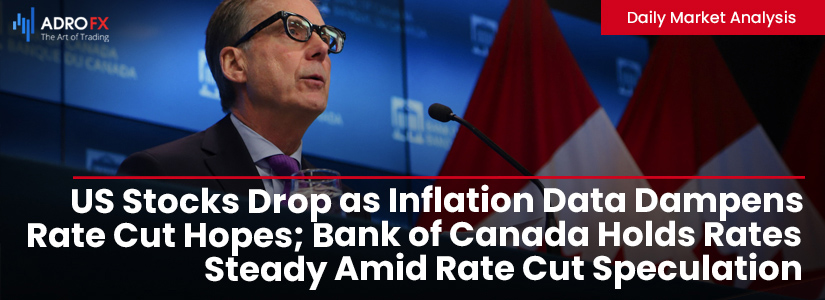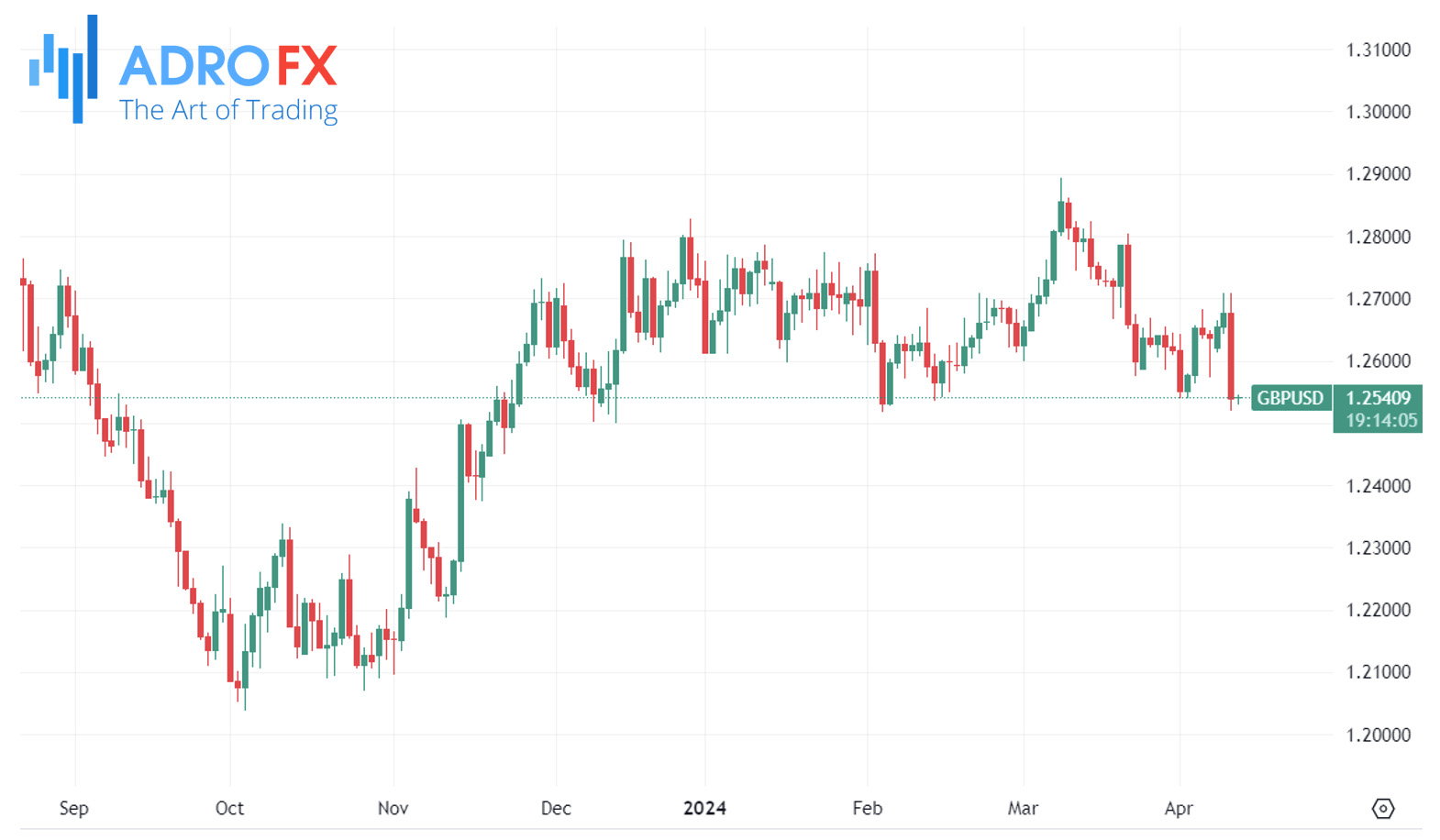US Stocks Drop as Inflation Data Dampens Rate Cut Hopes; Bank of Canada Holds Rates Steady Amid Rate Cut Speculation | Daily Market Analysis

Key events:
- Eurozone - Deposit Facility Rate (Apr)
- Eurozone - ECB Interest Rate Decision (Apr)
- USA - Initial Jobless Claims
- USA - PPI (MoM) (Mar)
- Eurozone - ECB Press Conference
- USA - 30-Year Bond Auction
Wednesday witnessed a downturn in US stocks as hotter-than-anticipated inflation data dashed hopes of an early interest rate cut by the Federal Reserve, sending ripples of concern across the market.
At the opening bell, all three major US stock indexes took a sharp dive following the release of the Labor Department's CPI report, which surpassed consensus estimates. This unexpected uptick served as a stark reminder that the path to bringing inflation back down to the Fed's 2% target will likely be lengthy and fraught with twists and turns.
The Dow Jones Industrial Average plunged by 422.16 points, representing a decline of 1.09%, closing at 38,461.51. Similarly, the S&P 500 index saw a loss of 49.27 points, or 0.95%, ending the day at 5,160.64, while the Nasdaq Composite dropped by 136.28 points, equivalent to 0.84%, to settle at 16,170.36.

Earlier data released on Wednesday revealed that the annualized reading of the consumer price index, a key metric closely monitored by investors, surged by 3.5% last month. This marked a significant increase from the 3.2% recorded in February and surpassed the expected 3.4%. The core figure, which excludes volatile elements like food and fuel, remained elevated at 3.8% year-on-year, well above the Federal Reserve's 2% medium-term target.
Federal Reserve officials have prioritized addressing inflation through a series of interest rate hikes, bringing borrowing costs to levels not seen in over two decades. During the March meeting, they projected a total of 75 basis points in rate cuts for the year but emphasized the need for further evidence of sustainable easing in price growth towards the 2% target.
Given the latest inflation data, the Fed has little incentive to commence interest rate cuts anytime soon, especially following the robust labor report released on Friday. Several Fed policymakers have cautioned that persistent inflation allows the central bank to maintain higher rates for an extended period.
Yields on both the 2-year Treasury bond and the benchmark 10-year note, which typically move inversely to prices, experienced significant increases on Wednesday.

Meanwhile, in currency markets, the GBP/USD pair is facing selling pressure near 1.2540 after rebounding from its 2024 low of 1.2520. The strengthening of the US Dollar was propelled by the unexpected rise in the US CPI data for March. Investors are eagerly anticipating Thursday's release of the US March PPI and weekly Initial Jobless Claims, followed by the UK monthly GDP figures later in the week.
Looking ahead, the Pound Sterling will be influenced by the UK's monthly GDP and February Industrial Production data set to be released on Friday. Market expectations lean towards a rate cut by the UK central bank after its June meeting. Any indication of potential rate cuts in May or dovish comments from Bank of England policymakers could weigh on the GBP, acting as a headwind for the GBP/USD pair.

Yesterday, the Bank of Canada announced its decision to maintain the policy interest rate at 5.00%, aligning with widespread expectations. However, the accompanying statement hinted at the possibility of future rate cuts. BoC Governor Macklem remarked that analysts or experts are observing the necessary conditions for lowering interest rates but emphasized the need for sustained progress toward price stability. Macklem also suggested that a rate cut in June is within the realm of possibility. Additionally, the BoC revised down its CPI inflation forecasts while upgrading its GDP growth projections.
Looking ahead to the next monetary policy meeting in June, analysts or experts anticipate a data-dependent approach. They speculate that as long as core inflation remains subdued and labor market trends remain contained, the BoC may opt for an initial 25 basis points rate cut. Furthermore, they predict subsequent rate cuts of 25 basis points each in July, September, and October, totaling a 100 basis points reduction by the end of 2024, bringing the policy rate to 4.00%. Overall, analysts or experts believe that the BoC will implement more rate cuts this year than currently anticipated by market participants for the rest of 2024. This divergence in easing between the Bank of Canada and the Federal Reserve could potentially weaken the Canadian dollar further in the coming months.

In the EUR/USD pair, the Euro remains under pressure near 1.0740 during the early Asian session on Thursday. Investors are closely monitoring the European Central Bank interest rate decision and press conference scheduled for later in the day, alongside the release of the US PPI report.
The ECB is expected to maintain interest rates at a record high during its April meeting, but ECB President Christine Lagarde may discuss inflation data and the potential for a rate cut in June. Conversely, the Fed may delay its easing cycle this year due to the strong economy and upward surprises in inflation. Although the ECB insists on independent policy setting, the divergence in interest rates between the Fed and ECB could exert selling pressure on the Euro and create headwinds for the EUR/USD pair.

Investor attention now turns to Thursday's release of the producer prices report, which promises to offer further insights into March's inflation dynamics. Additionally, the unofficial commencement of first-quarter earnings season will be in focus, with a trio of major banks, including JPMorgan Chase & Co (NYSE: JPM), Citigroup Inc (NYSE: C), and Wells Fargo & Co, scheduled to unveil their results on Friday.









